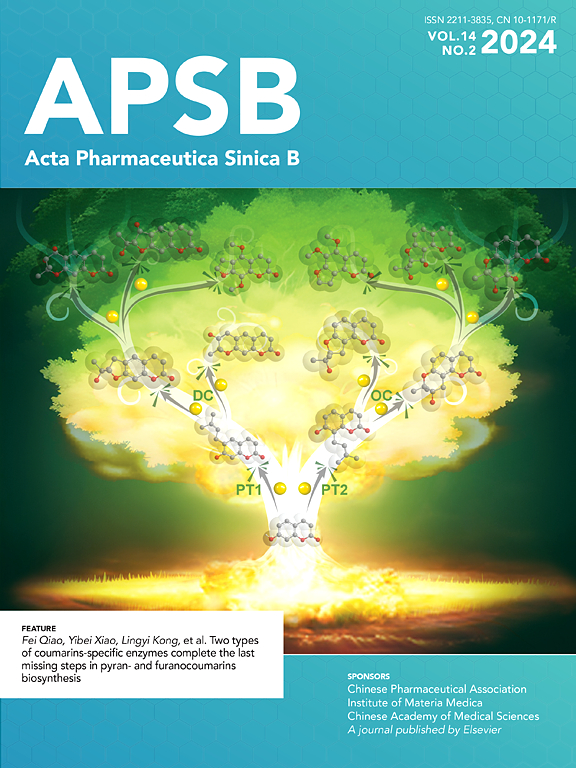Cannabidiol alleviates methamphetamine addiction via targeting ATP5A1 and modulating the ATP–ADO–A1R signaling pathway
IF 14.6
1区 医学
Q1 PHARMACOLOGY & PHARMACY
引用次数: 0
Abstract
Cannabidiol (CBD), a non-psychoactive cannabinoid, shows great promise in treating methamphetamine (METH) addiction. Nonetheless, the molecular target and the mechanism through which CBD treats METH addiction remain unexplored. Herein, CBD was shown to counteract METH-induced locomotor sensitization and conditioned place preference. Additionally, CBD mitigated the adverse effects of METH, such as cristae loss, a decline in ATP content, and a reduction in membrane potential. Employing an activity-based protein profiling approach, a target fishing strategy was used to uncover CBD's direct target. ATP5A1, a subunit of ATP synthase, was identified and validated as a CBD target. Moreover, CBD demonstrated the ability to ameliorate METH-induced ubiquitination of ATP5A1 via the D376 residue, thereby reversing the METH-induced reduction of ATP5A1 and promoting the assembly of ATP synthase. Pharmacological inhibition of the ATP efflux channel pannexin 1, blockade of ATP hydrolysis by a CD39 inhibitor, and blocking the adenosine A1 receptor (A1R) all attenuated the therapeutic benefits of CBD in mitigating METH-induced behavioral sensitization and CPP. Moreover, the RNA interference of ATP5A1 in the ventral tegmental area resulted in the reversal of CBD's therapeutic efficacy against METH addiction. Collectively, these data show that ATP5A1 is a target for CBD to inhibit METH-induced addiction behaviors through the ADO–A1R signaling pathway.

大麻二酚通过靶向ATP5A1和调节ATP-ADO-A1R信号通路来缓解甲基苯丙胺成瘾
大麻二酚(CBD)是一种非精神活性大麻素,在治疗甲基苯丙胺(冰毒)成瘾方面显示出很大的希望。尽管如此,CBD治疗冰毒成瘾的分子靶点和机制仍未被探索。在这项研究中,CBD被证明可以抵消甲基苯丙胺诱导的运动敏化和条件位置偏好。此外,CBD减轻了甲基苯丙胺的副作用,如嵴丢失、ATP含量下降和膜电位降低。采用基于活性的蛋白质分析方法,使用目标捕捞策略来发现CBD的直接目标。ATP5A1是ATP合成酶的一个亚基,被鉴定并验证为CBD的靶标。此外,CBD能够通过D376残基改善甲基甲醚诱导的ATP5A1泛素化,从而逆转甲基甲醚诱导的ATP5A1的还原,促进ATP合成酶的组装。ATP外排通道pannexin 1的药理抑制,CD39抑制剂阻断ATP水解,以及腺苷A1受体(A1R)的阻断,都减弱了CBD在缓解冰毒诱导的行为致敏和CPP方面的治疗效果。此外,腹侧被盖区ATP5A1的RNA干扰导致CBD对冰毒成瘾的治疗效果逆转。综上所述,这些数据表明ATP5A1是CBD通过ADO-A1R信号通路抑制meth诱导的成瘾行为的靶点。
本文章由计算机程序翻译,如有差异,请以英文原文为准。
求助全文
约1分钟内获得全文
求助全文
来源期刊

Acta Pharmaceutica Sinica. B
Pharmacology, Toxicology and Pharmaceutics-General Pharmacology, Toxicology and Pharmaceutics
CiteScore
22.40
自引率
5.50%
发文量
1051
审稿时长
19 weeks
期刊介绍:
The Journal of the Institute of Materia Medica, Chinese Academy of Medical Sciences, and the Chinese Pharmaceutical Association oversees the peer review process for Acta Pharmaceutica Sinica. B (APSB).
Published monthly in English, APSB is dedicated to disseminating significant original research articles, rapid communications, and high-quality reviews that highlight recent advances across various pharmaceutical sciences domains. These encompass pharmacology, pharmaceutics, medicinal chemistry, natural products, pharmacognosy, pharmaceutical analysis, and pharmacokinetics.
A part of the Acta Pharmaceutica Sinica series, established in 1953 and indexed in prominent databases like Chemical Abstracts, Index Medicus, SciFinder Scholar, Biological Abstracts, International Pharmaceutical Abstracts, Cambridge Scientific Abstracts, and Current Bibliography on Science and Technology, APSB is sponsored by the Institute of Materia Medica, Chinese Academy of Medical Sciences, and the Chinese Pharmaceutical Association. Its production and hosting are facilitated by Elsevier B.V. This collaborative effort ensures APSB's commitment to delivering valuable contributions to the pharmaceutical sciences community.
 求助内容:
求助内容: 应助结果提醒方式:
应助结果提醒方式:


